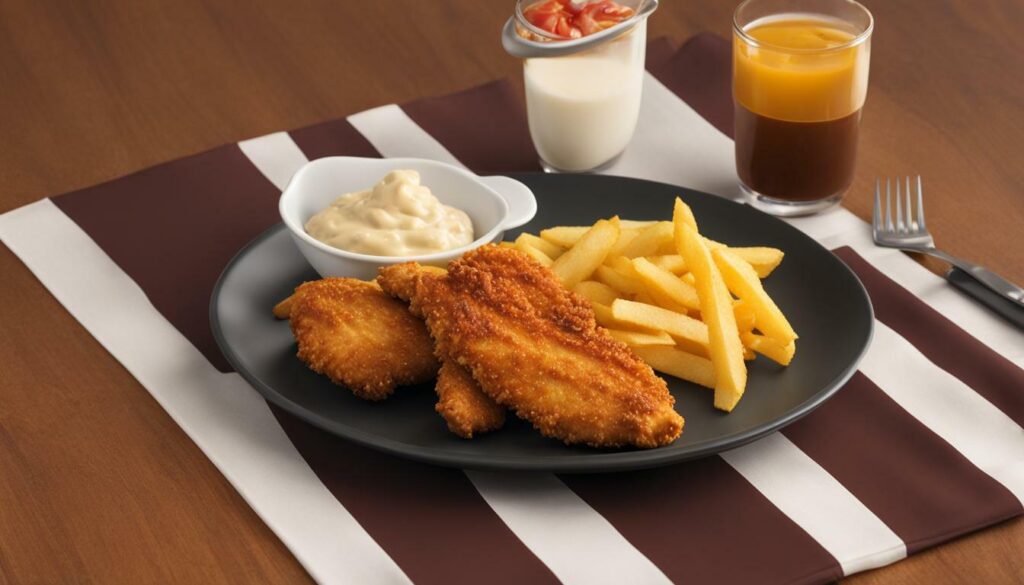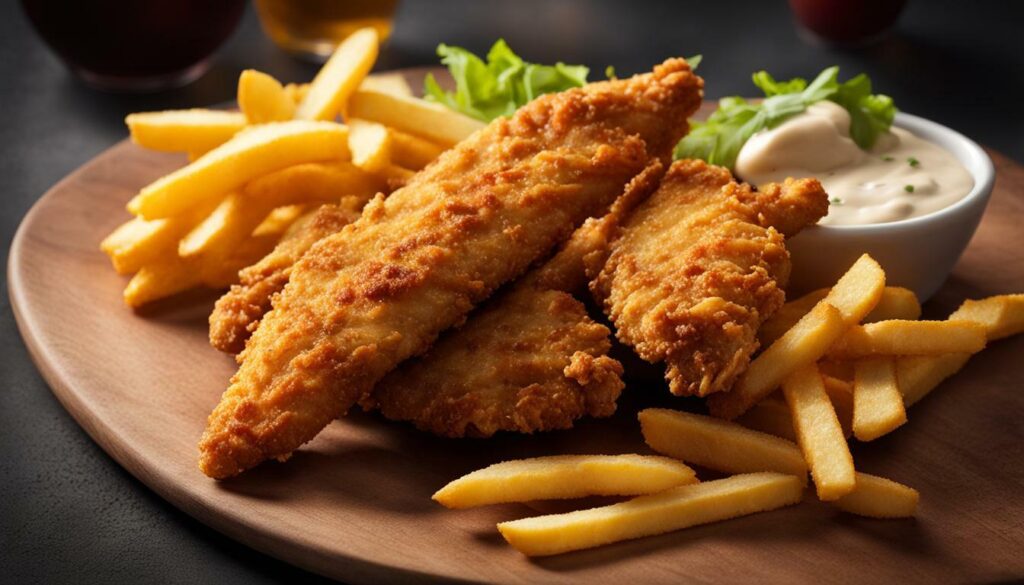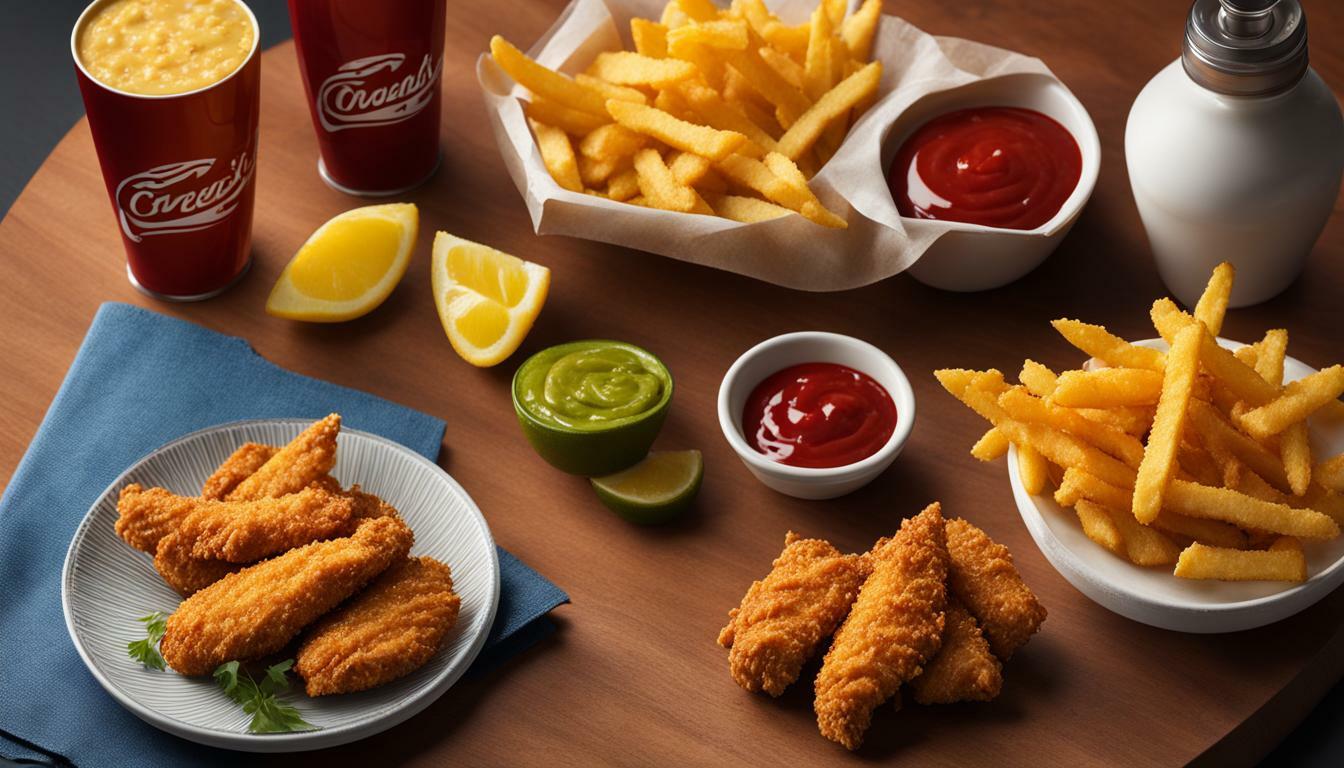Are you curious about the calorie count in your favorite meal of chicken tenders and fries? In this guide, we’ll delve into the surprising details of chicken tenders calories and uncover the nutritional information you need to know.
Fried foods, like chicken tenders and fries, often contain high amounts of fat and sodium. Understanding the calorie count is essential for making informed choices about your diet. Let’s break it down.
Key Takeaways:
- Chicken tenders and fries are popular fast-food options that can be high in calories, fat, and sodium.
- A single serving of fast-food chicken tenders contains approximately 499 calories, 25.7g of fat, and 1410mg of sodium.
- The actual calorie count and nutritional value may vary depending on the brand and preparation method.
- Chicken tenders are a good source of protein and provide minerals like selenium, niacin, vitamin B6, and phosphorus.
- Different fast-food chains offer variations in the calorie count and nutritional values of chicken tenders and fries.
The Calorie Count of Chicken Tenders and Fries
Let’s start by understanding the calorie count of chicken tenders and fries. According to the USDA, a single serving of fast-food chicken tenders provides 499 calories. This means that indulging in this popular combination can quickly add up, especially if consumed regularly.

When we break down the calorie count further, we find that a serving of chicken tenders contains 25.7 grams of fat, 1410 milligrams of sodium, 31.7 grams of carbohydrates, 2.2 grams of fiber, 0.7 grams of sugar, and 35.4 grams of protein. It’s important to note that these numbers are based on fast-food chicken tenders and may vary depending on the brand and preparation method.
Fried chicken tenders, as the name suggests, are cooked in oil, which significantly contributes to their calorie count and fat content. With nearly 26 grams of fat per serving, including saturated, monounsaturated, and polyunsaturated fats, it’s crucial to be mindful of your intake if you’re watching your fat consumption. However, chicken tenders are also a good source of protein and provide minerals like selenium, niacin, vitamin B6, and phosphorus, which are essential for overall health.
It’s worth mentioning that different fast-food chains offer their own variations of chicken tenders and fries, leading to differences in calorie counts and nutritional values. Additionally, sodium content can be a concern, as some servings may exceed the daily recommended intake. Therefore, it’s important to check the nutrition information provided by the specific brand or restaurant before making your food choices.
| Nutrient | Amount per Serving |
|---|---|
| Calories | 499 |
| Fat | 25.7g |
| Sodium | 1410mg |
| Carbohydrates | 31.7g |
| Fiber | 2.2g |
| Sugar | 0.7g |
| Protein | 35.4g |
Nutritional Breakdown of Chicken Tenders
Chicken tenders not only provide calories but also a range of nutrients. In a single serving, you’ll find 25.7g of fat, 1410mg of sodium, 31.7g of carbohydrates, 2.2g of fiber, 0.7g of sugar, and 35.4g of protein. It’s important to be aware of these values when considering the nutritional content of chicken tenders.
Let’s take a closer look at the macronutrients in chicken tenders. The fat content is relatively high, with almost 26g per serving. It’s worth noting that this includes different types of fats, including saturated, monounsaturated, and polyunsaturated fats. While some fats are necessary for our bodies, it’s important to consume them in moderation.
In addition to fat, chicken tenders also contain carbohydrates, fiber, and sugar. The carbohydrate content is 31.7g, providing energy to fuel your activities. The fiber content is 2.2g, which contributes to a healthy digestive system. The sugar content is relatively low, with only 0.7g per serving.
Lastly, chicken tenders are a great source of protein, with 35.4g per serving. Protein is essential for building and repairing tissues, making it an important nutrient for muscle growth and maintenance. It’s also worth mentioning that chicken tenders contain important minerals, including selenium, niacin, vitamin B6, and phosphorus, which contribute to overall health and wellbeing.
Understanding the nutritional breakdown of chicken tenders can help you make informed choices about your diet. By being aware of the fat, sodium, carbohydrate, fiber, sugar, and protein content, you can incorporate chicken tenders into a balanced meal plan that suits your individual nutritional needs.
| Nutrient | Amount per Serving |
|---|---|
| Calories | 499 |
| Fat | 25.7g |
| Sodium | 1410mg |
| Carbohydrates | 31.7g |
| Fiber | 2.2g |
| Sugar | 0.7g |
| Protein | 35.4g |

Understanding the Fat Content in Chicken Tenders
When it comes to chicken tenders, fat plays a significant role in the calorie count and overall nutritional value. A single serving contains nearly 26g of fat, including saturated, monounsaturated, and polyunsaturated fats. It’s important to understand the impact of these fats on our health.
Saturated fats, also known as “bad fats,” can increase cholesterol levels and raise the risk of heart disease. Monounsaturated fats, on the other hand, are considered “good fats” that can help lower cholesterol and reduce the risk of heart disease. Polyunsaturated fats, like omega-3 and omega-6 fatty acids, are essential fats that our bodies need for proper functioning.
To maintain a balanced diet, it’s important to limit the consumption of saturated fats and choose healthier cooking methods. Instead of deep-frying chicken tenders, which can increase the fat content, consider baking them in the oven. This method can reduce the overall fat content while still providing a delicious and crispy texture.
| Fat Type | Amount per Serving |
|---|---|
| Saturated Fat | 12.7g |
| Monounsaturated Fat | 6.3g |
| Polyunsaturated Fat | 4.2g |
It’s important to remember that fat is an essential part of our diet, but choosing the right types and moderating our intake is key. By understanding the fat content in chicken tenders, we can make more informed decisions about our meal choices and work towards a healthier lifestyle.

In addition to the calorie count and fat content, chicken tenders provide a range of essential nutrients. These include selenium, niacin, vitamin B6, and phosphorus, which contribute to overall health and wellness. Selenium is a powerful antioxidant that helps protect the body against oxidative stress and supports a healthy immune system. Niacin, also known as vitamin B3, plays a crucial role in energy production and the maintenance of healthy skin, nerves, and digestion. Vitamin B6 is involved in the metabolism of proteins, carbohydrates, and fats, and is necessary for the production of neurotransmitters and red blood cells. Phosphorus is essential for the formation and maintenance of strong bones and teeth, as well as for energy production and cell signaling.
To better understand the nutritional value of chicken tenders, let’s take a look at the table below:
| Nutrient | Amount per Serving |
|---|---|
| Calories | 499 |
| Total Fat | 25.7g |
| Sodium | 1410mg |
| Carbohydrates | 31.7g |
| Fiber | 2.2g |
| Sugar | 0.7g |
| Protein | 35.4g |
It’s important to keep in mind that these values may vary depending on the brand and preparation method. However, chicken tenders are generally a good source of protein and provide important minerals that contribute to a well-balanced diet. To maintain a healthy lifestyle, it’s recommended to consume chicken tenders in moderation and pair them with nutritious side dishes and vegetables. Now, let’s continue exploring the variations in calorie counts and nutritional values in the upcoming sections.

It’s worth noting that the calorie count and nutritional value of chicken tenders and fries may vary depending on the fast-food chain. It’s essential to check the nutrition information provided by specific brands. Different fast-food chains offer variations in the calorie counts and nutritional values of their chicken tenders and fries. This is due to differences in preparation methods, portion sizes, and added ingredients.
To give you a better idea of the variations, let’s compare two popular fast-food chains. Chain A offers a serving of chicken tenders and fries with a total calorie count of 520. This includes 29 grams of fat, 1380 milligrams of sodium, 36 grams of carbohydrates, and 29 grams of protein. On the other hand, Chain B provides a serving with a calorie count of 490, 25 grams of fat, 1470 milligrams of sodium, 34 grams of carbohydrates, and 28 grams of protein. As you can see, even though the overall calorie counts are relatively close, the fat, sodium, and carbohydrate content can differ.
When it comes to making healthier choices, understanding these variations is crucial. By comparing the nutrition information from different fast-food chains, you can make an informed decision about which option aligns best with your dietary needs and goals. Additionally, if you are concerned about specific nutrients like sodium or fat, checking the nutrition labels will help you choose the option that suits you best.
Variations in Nutritional Values:
| Calories | Fat (g) | Sodium (mg) | Carbohydrates (g) | Protein (g) | |
|---|---|---|---|---|---|
| Chain A | 520 | 29 | 1380 | 36 | 29 |
| Chain B | 490 | 25 | 1470 | 34 | 28 |
As you can see from the table above, there are slight variations in the nutritional values between Chain A and Chain B. However, both options provide a significant amount of fat and sodium. If you are trying to reduce your intake of these nutrients, you may want to consider making chicken tenders and fries at home, where you can control the ingredients and cooking methods.
Remember that these variations in calorie counts and nutritional values are specific to the examples provided. It’s important to check the nutrition information provided by the fast-food chains you visit or the specific brands you choose. By being mindful of these variations, you can make healthier choices that align with your dietary goals.

While chicken tenders and fries can be a tasty meal, it’s important to be aware of the sodium content. Some servings can exceed the daily recommended intake, which can have negative health effects. The USDA states that a serving of fast-food chicken tenders provides 1410mg of sodium, which is more than half of the recommended daily limit for adult individuals. Excessive sodium intake can lead to high blood pressure, increased risk of heart disease, and other health problems.
To put it into perspective, the American Heart Association recommends limiting sodium intake to 1500mg per day for ideal heart health. Consuming just one serving of chicken tenders and fries can already put you over that limit. It’s important to be mindful of your sodium consumption and make smart choices to maintain a healthy diet.
“Excessive sodium intake can lead to high blood pressure, increased risk of heart disease, and other health problems.”
One way to reduce your sodium intake is by making healthier choices when it comes to chicken tenders and fries. Consider baking homemade chicken tenders in the oven instead of frying them. Baking not only cuts down on the amount of oil used but also reduces the sodium content. Additionally, you can opt for sweet potato fries instead of regular fries to further decrease your sodium intake, as sweet potatoes naturally contain less sodium than regular potatoes.

| Nutrient | Amount per Serving |
|---|---|
| Calories | 499 |
| Fat | 25.7g |
| Sodium | 1410mg |
| Carbohydrates | 31.7g |
| Fiber | 2.2g |
| Sugar | 0.7g |
| Protein | 35.4g |
In conclusion, while chicken tenders and fries may be a delicious indulgence, they come with a significant sodium content that should be monitored for a healthy diet. Opting for homemade baked chicken tenders and swapping regular fries for sweet potato fries can help reduce sodium intake. By being mindful of the sodium content in your meals, you can make healthier choices and maintain a balanced diet.
Proper Handling and Preparation of Chicken Tenders
Whether you buy chicken tenders from a restaurant or make them at home, proper storage, handling, and preparation are crucial. If you’re looking for a healthier alternative, consider baking chicken tenders in the oven instead of frying them.
When storing raw chicken tenders, it’s important to keep them refrigerated at a temperature below 40°F (4°C) to prevent the growth of harmful bacteria. Store them in a sealed container or airtight bag to avoid any cross-contamination with other foods in the refrigerator.
Prior to cooking, it’s recommended to thaw frozen chicken tenders in the refrigerator overnight or under cold running water. Avoid thawing them at room temperature, as this can promote bacterial growth.
When it comes to cooking chicken tenders, baking them in the oven is a healthier option compared to frying. Preheat your oven to 400°F (200°C) and place the tenders on a baking sheet lined with parchment paper. Brush them lightly with olive oil or another preferred cooking oil and season with herbs and spices of your choice. Bake for about 15-20 minutes or until the internal temperature reaches 165°F (74°C). Baking chicken tenders helps reduce the amount of added fat while still providing a delicious and crispy texture.
| Method | Calories | Total Fat (g) | Sodium (mg) |
|---|---|---|---|
| Fried Chicken Tenders | 499 | 25.7 | 1410 |
| Baked Chicken Tenders | 380 | 9.8 | 430 |
By baking chicken tenders instead of frying, you can significantly reduce the calorie count and fat content. As shown in the comparison table, baked chicken tenders have approximately 119 fewer calories and 15.9g less fat than fried chicken tenders per serving. This healthier cooking method allows you to enjoy the deliciousness of chicken tenders while making a more nutritious choice.
Remember to always follow proper food safety guidelines when handling and cooking raw chicken tenders. By storing them correctly, thawing them safely, and choosing healthier cooking methods, you can enjoy chicken tenders that are not only tasty but also better for your overall health.

Making homemade chicken tenders and fries allows you to take control of the ingredients and nutritional values. You can create a healthier version by using lighter cooking methods and opting for leaner cuts of chicken. Instead of deep-frying, try baking the chicken tenders in the oven. This method reduces the amount of oil used and results in a crispy texture. You can also experiment with different coatings, such as whole wheat breadcrumbs or crushed cornflakes, to add flavor and crunch without adding excess calories and fat.
When making homemade fries, consider using sweet potatoes or alternative root vegetables instead of regular potatoes. Sweet potatoes are rich in vitamins and minerals and have a lower glycemic index, making them a healthier choice. Cut the potatoes into wedges or thin strips, toss them in a small amount of olive oil, and bake them in the oven until crispy. This method reduces the amount of oil and eliminates the need for deep-frying.
Adding a variety of herbs and spices to your homemade chicken tenders and fries can enhance the flavor without adding extra calories or sodium. Experiment with combinations like garlic powder, paprika, and dried herbs like thyme or rosemary to create a delicious and healthier alternative to fast-food options.

| Nutritional Information | Chicken Tenders (per serving) | Fries (per serving) |
|---|---|---|
| Calories | 220 | 150 |
| Fat (g) | 6 | 8 |
| Sodium (mg) | 400 | 160 |
| Carbohydrates (g) | 12 | 30 |
| Fiber (g) | 0 | 3 |
| Sugar (g) | 0 | 0 |
| Protein (g) | 25 | 2 |
By making homemade chicken tenders and fries, you can enjoy a delicious meal while being mindful of the calorie count and nutritional value. Remember to choose lean cuts of chicken, opt for baking instead of frying, and use herbs and spices to enhance the flavor. With a little creativity and healthier cooking methods, you can indulge in this classic dish without sacrificing your health goals.
Conclusion
Understanding the calorie count and nutritional value of chicken tenders and fries can help you make informed choices and maintain a balanced diet. According to the USDA, a single serving of fast-food chicken tenders provides 499 calories, 25.7g of fat, 1410mg of sodium, 31.7g of carbohydrates, 2.2g of fiber, 0.7g of sugar, and 35.4g of protein.
It’s important to note that the actual calorie count and nutritional value may vary depending on the brand and preparation method. Fried chicken tenders are known to be high in fat, with nearly 26g per serving, including saturated, monounsaturated, and polyunsaturated fats. However, they are also a good source of protein and provide minerals like selenium, niacin, vitamin B6, and phosphorus.
Different fast-food chains offer variations of chicken tenders and fries, with varying calorie counts and nutritional values. It’s crucial to be mindful of the sodium content, as some servings can exceed the daily recommended intake. To ensure proper handling and preparation, it’s essential to follow food safety guidelines, especially if frying or handling raw chicken.
For a healthier option, consider preparing chicken tenders at home by baking them in the oven instead of frying. This can help reduce the overall calorie count and fat content while still enjoying the taste and texture of this popular dish. By taking control of the ingredients and cooking method, you can create a more nutritious version of chicken tenders and fries.
FAQ
Q: Why is it important to break down the calories in chicken tenders and fries?
A: Breaking down the calories in chicken tenders and fries is important because fried foods often contain high amounts of fat and sodium. Understanding the calorie count can help you make informed choices about your diet.
Q: How many calories are in a serving of fast-food chicken tenders?
A: According to the USDA, a single serving of fast-food chicken tenders provides 499 calories.
Q: What is the fat content in chicken tenders?
A: A serving of chicken tenders contains 25.7g of fat, including saturated, monounsaturated, and polyunsaturated fats.
Q: What nutritional value do chicken tenders provide?
A: Chicken tenders are a good source of protein and provide minerals like selenium, niacin, vitamin B6, and phosphorus.
Q: Do different fast-food chains offer variations in calorie counts and nutritional values?
A: Yes, different fast-food chains may have different calorie counts and nutritional values for their chicken tenders.
Q: Is the sodium content in chicken tenders and fries something to be mindful of?
A: Yes, it’s important to be mindful of the sodium content in chicken tenders and fries, as some servings can exceed the daily recommended intake.
Q: How should fried chicken tenders be handled and stored?
A: Proper storage and handling of fried chicken tenders will depend on whether they are purchased from a restaurant or made at home. Raw chicken should be handled safely to avoid bacterial contamination.
Q: Is there a healthier alternative to frying chicken tenders?
A: Yes, for a healthier option, chicken tenders can be prepared at home by baking them in the oven instead of frying.
How Many Calories are in Fried Potatoes, Specifically Fries?
Fried potatoes, specifically fries, can be quite calorie-dense. On average, a medium serving of fries contains around 365 calories. However, this number can easily increase depending on factors like cooking method and portion size. It is important to be mindful of the calories in fried potatoes and consume them in moderation as part of a balanced diet.
Understanding the Fat Content in Chicken Tenders
When it comes to chicken tenders, fat plays a significant role in the calorie count and overall nutritional value. A single serving contains nearly 26g of fat, including saturated, monounsaturated, and polyunsaturated fats. It’s important to understand the impact of these fats on our health.
Saturated fats, also known as “bad fats,” can increase cholesterol levels and raise the risk of heart disease. Monounsaturated fats, on the other hand, are considered “good fats” that can help lower cholesterol and reduce the risk of heart disease. Polyunsaturated fats, like omega-3 and omega-6 fatty acids, are essential fats that our bodies need for proper functioning.
To maintain a balanced diet, it’s important to limit the consumption of saturated fats and choose healthier cooking methods. Instead of deep-frying chicken tenders, which can increase the fat content, consider baking them in the oven. This method can reduce the overall fat content while still providing a delicious and crispy texture.
| Fat Type | Amount per Serving |
|---|---|
| Saturated Fat | 12.7g |
| Monounsaturated Fat | 6.3g |
| Polyunsaturated Fat | 4.2g |
It’s important to remember that fat is an essential part of our diet, but choosing the right types and moderating our intake is key. By understanding the fat content in chicken tenders, we can make more informed decisions about our meal choices and work towards a healthier lifestyle.
In addition to the calorie count and fat content, chicken tenders provide a range of essential nutrients. These include selenium, niacin, vitamin B6, and phosphorus, which contribute to overall health and wellness. Selenium is a powerful antioxidant that helps protect the body against oxidative stress and supports a healthy immune system. Niacin, also known as vitamin B3, plays a crucial role in energy production and the maintenance of healthy skin, nerves, and digestion. Vitamin B6 is involved in the metabolism of proteins, carbohydrates, and fats, and is necessary for the production of neurotransmitters and red blood cells. Phosphorus is essential for the formation and maintenance of strong bones and teeth, as well as for energy production and cell signaling.
To better understand the nutritional value of chicken tenders, let’s take a look at the table below:
| Nutrient | Amount per Serving |
|---|---|
| Calories | 499 |
| Total Fat | 25.7g |
| Sodium | 1410mg |
| Carbohydrates | 31.7g |
| Fiber | 2.2g |
| Sugar | 0.7g |
| Protein | 35.4g |
It’s important to keep in mind that these values may vary depending on the brand and preparation method. However, chicken tenders are generally a good source of protein and provide important minerals that contribute to a well-balanced diet. To maintain a healthy lifestyle, it’s recommended to consume chicken tenders in moderation and pair them with nutritious side dishes and vegetables. Now, let’s continue exploring the variations in calorie counts and nutritional values in the upcoming sections.
It’s worth noting that the calorie count and nutritional value of chicken tenders and fries may vary depending on the fast-food chain. It’s essential to check the nutrition information provided by specific brands. Different fast-food chains offer variations in the calorie counts and nutritional values of their chicken tenders and fries. This is due to differences in preparation methods, portion sizes, and added ingredients.
To give you a better idea of the variations, let’s compare two popular fast-food chains. Chain A offers a serving of chicken tenders and fries with a total calorie count of 520. This includes 29 grams of fat, 1380 milligrams of sodium, 36 grams of carbohydrates, and 29 grams of protein. On the other hand, Chain B provides a serving with a calorie count of 490, 25 grams of fat, 1470 milligrams of sodium, 34 grams of carbohydrates, and 28 grams of protein. As you can see, even though the overall calorie counts are relatively close, the fat, sodium, and carbohydrate content can differ.
When it comes to making healthier choices, understanding these variations is crucial. By comparing the nutrition information from different fast-food chains, you can make an informed decision about which option aligns best with your dietary needs and goals. Additionally, if you are concerned about specific nutrients like sodium or fat, checking the nutrition labels will help you choose the option that suits you best.
Variations in Nutritional Values:
| Calories | Fat (g) | Sodium (mg) | Carbohydrates (g) | Protein (g) | |
|---|---|---|---|---|---|
| Chain A | 520 | 29 | 1380 | 36 | 29 |
| Chain B | 490 | 25 | 1470 | 34 | 28 |
As you can see from the table above, there are slight variations in the nutritional values between Chain A and Chain B. However, both options provide a significant amount of fat and sodium. If you are trying to reduce your intake of these nutrients, you may want to consider making chicken tenders and fries at home, where you can control the ingredients and cooking methods.
Remember that these variations in calorie counts and nutritional values are specific to the examples provided. It’s important to check the nutrition information provided by the fast-food chains you visit or the specific brands you choose. By being mindful of these variations, you can make healthier choices that align with your dietary goals.
While chicken tenders and fries can be a tasty meal, it’s important to be aware of the sodium content. Some servings can exceed the daily recommended intake, which can have negative health effects. The USDA states that a serving of fast-food chicken tenders provides 1410mg of sodium, which is more than half of the recommended daily limit for adult individuals. Excessive sodium intake can lead to high blood pressure, increased risk of heart disease, and other health problems.
To put it into perspective, the American Heart Association recommends limiting sodium intake to 1500mg per day for ideal heart health. Consuming just one serving of chicken tenders and fries can already put you over that limit. It’s important to be mindful of your sodium consumption and make smart choices to maintain a healthy diet.
“Excessive sodium intake can lead to high blood pressure, increased risk of heart disease, and other health problems.”
One way to reduce your sodium intake is by making healthier choices when it comes to chicken tenders and fries. Consider baking homemade chicken tenders in the oven instead of frying them. Baking not only cuts down on the amount of oil used but also reduces the sodium content. Additionally, you can opt for sweet potato fries instead of regular fries to further decrease your sodium intake, as sweet potatoes naturally contain less sodium than regular potatoes.
| Nutrient | Amount per Serving |
|---|---|
| Calories | 499 |
| Fat | 25.7g |
| Sodium | 1410mg |
| Carbohydrates | 31.7g |
| Fiber | 2.2g |
| Sugar | 0.7g |
| Protein | 35.4g |
In conclusion, while chicken tenders and fries may be a delicious indulgence, they come with a significant sodium content that should be monitored for a healthy diet. Opting for homemade baked chicken tenders and swapping regular fries for sweet potato fries can help reduce sodium intake. By being mindful of the sodium content in your meals, you can make healthier choices and maintain a balanced diet.
Proper Handling and Preparation of Chicken Tenders
Whether you buy chicken tenders from a restaurant or make them at home, proper storage, handling, and preparation are crucial. If you’re looking for a healthier alternative, consider baking chicken tenders in the oven instead of frying them.
When storing raw chicken tenders, it’s important to keep them refrigerated at a temperature below 40°F (4°C) to prevent the growth of harmful bacteria. Store them in a sealed container or airtight bag to avoid any cross-contamination with other foods in the refrigerator.
Prior to cooking, it’s recommended to thaw frozen chicken tenders in the refrigerator overnight or under cold running water. Avoid thawing them at room temperature, as this can promote bacterial growth.
When it comes to cooking chicken tenders, baking them in the oven is a healthier option compared to frying. Preheat your oven to 400°F (200°C) and place the tenders on a baking sheet lined with parchment paper. Brush them lightly with olive oil or another preferred cooking oil and season with herbs and spices of your choice. Bake for about 15-20 minutes or until the internal temperature reaches 165°F (74°C). Baking chicken tenders helps reduce the amount of added fat while still providing a delicious and crispy texture.
| Method | Calories | Total Fat (g) | Sodium (mg) |
|---|---|---|---|
| Fried Chicken Tenders | 499 | 25.7 | 1410 |
| Baked Chicken Tenders | 380 | 9.8 | 430 |
By baking chicken tenders instead of frying, you can significantly reduce the calorie count and fat content. As shown in the comparison table, baked chicken tenders have approximately 119 fewer calories and 15.9g less fat than fried chicken tenders per serving. This healthier cooking method allows you to enjoy the deliciousness of chicken tenders while making a more nutritious choice.
Remember to always follow proper food safety guidelines when handling and cooking raw chicken tenders. By storing them correctly, thawing them safely, and choosing healthier cooking methods, you can enjoy chicken tenders that are not only tasty but also better for your overall health.
Making homemade chicken tenders and fries allows you to take control of the ingredients and nutritional values. You can create a healthier version by using lighter cooking methods and opting for leaner cuts of chicken. Instead of deep-frying, try baking the chicken tenders in the oven. This method reduces the amount of oil used and results in a crispy texture. You can also experiment with different coatings, such as whole wheat breadcrumbs or crushed cornflakes, to add flavor and crunch without adding excess calories and fat.
When making homemade fries, consider using sweet potatoes or alternative root vegetables instead of regular potatoes. Sweet potatoes are rich in vitamins and minerals and have a lower glycemic index, making them a healthier choice. Cut the potatoes into wedges or thin strips, toss them in a small amount of olive oil, and bake them in the oven until crispy. This method reduces the amount of oil and eliminates the need for deep-frying.
Adding a variety of herbs and spices to your homemade chicken tenders and fries can enhance the flavor without adding extra calories or sodium. Experiment with combinations like garlic powder, paprika, and dried herbs like thyme or rosemary to create a delicious and healthier alternative to fast-food options.
| Nutritional Information | Chicken Tenders (per serving) | Fries (per serving) |
|---|---|---|
| Calories | 220 | 150 |
| Fat (g) | 6 | 8 |
| Sodium (mg) | 400 | 160 |
| Carbohydrates (g) | 12 | 30 |
| Fiber (g) | 0 | 3 |
| Sugar (g) | 0 | 0 |
| Protein (g) | 25 | 2 |
By making homemade chicken tenders and fries, you can enjoy a delicious meal while being mindful of the calorie count and nutritional value. Remember to choose lean cuts of chicken, opt for baking instead of frying, and use herbs and spices to enhance the flavor. With a little creativity and healthier cooking methods, you can indulge in this classic dish without sacrificing your health goals.
Conclusion
Understanding the calorie count and nutritional value of chicken tenders and fries can help you make informed choices and maintain a balanced diet. According to the USDA, a single serving of fast-food chicken tenders provides 499 calories, 25.7g of fat, 1410mg of sodium, 31.7g of carbohydrates, 2.2g of fiber, 0.7g of sugar, and 35.4g of protein.
It’s important to note that the actual calorie count and nutritional value may vary depending on the brand and preparation method. Fried chicken tenders are known to be high in fat, with nearly 26g per serving, including saturated, monounsaturated, and polyunsaturated fats. However, they are also a good source of protein and provide minerals like selenium, niacin, vitamin B6, and phosphorus.
Different fast-food chains offer variations of chicken tenders and fries, with varying calorie counts and nutritional values. It’s crucial to be mindful of the sodium content, as some servings can exceed the daily recommended intake. To ensure proper handling and preparation, it’s essential to follow food safety guidelines, especially if frying or handling raw chicken.
For a healthier option, consider preparing chicken tenders at home by baking them in the oven instead of frying. This can help reduce the overall calorie count and fat content while still enjoying the taste and texture of this popular dish. By taking control of the ingredients and cooking method, you can create a more nutritious version of chicken tenders and fries.
FAQ
Q: Why is it important to break down the calories in chicken tenders and fries?
A: Breaking down the calories in chicken tenders and fries is important because fried foods often contain high amounts of fat and sodium. Understanding the calorie count can help you make informed choices about your diet.
Q: How many calories are in a serving of fast-food chicken tenders?
A: According to the USDA, a single serving of fast-food chicken tenders provides 499 calories.
Q: What is the fat content in chicken tenders?
A: A serving of chicken tenders contains 25.7g of fat, including saturated, monounsaturated, and polyunsaturated fats.
Q: What nutritional value do chicken tenders provide?
A: Chicken tenders are a good source of protein and provide minerals like selenium, niacin, vitamin B6, and phosphorus.
Q: Do different fast-food chains offer variations in calorie counts and nutritional values?
A: Yes, different fast-food chains may have different calorie counts and nutritional values for their chicken tenders.
Q: Is the sodium content in chicken tenders and fries something to be mindful of?
A: Yes, it’s important to be mindful of the sodium content in chicken tenders and fries, as some servings can exceed the daily recommended intake.
Q: How should fried chicken tenders be handled and stored?
A: Proper storage and handling of fried chicken tenders will depend on whether they are purchased from a restaurant or made at home. Raw chicken should be handled safely to avoid bacterial contamination.
Q: Is there a healthier alternative to frying chicken tenders?
A: Yes, for a healthier option, chicken tenders can be prepared at home by baking them in the oven instead of frying.





Leave a Reply